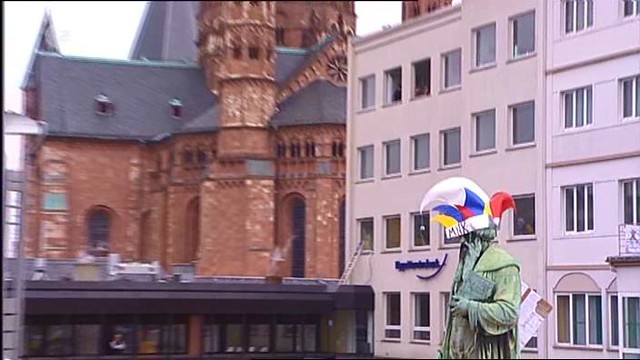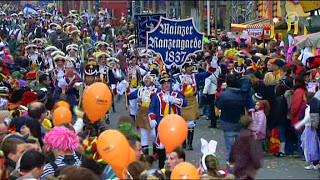A big thank you to the Riskies for letting me step in as a temporary contributor to their blog! For my debut, I’m showering you with confetti, for today is the last day of carnival, the “fifth season,” here in Germany. “Carnival in Germany???” some of you might say. “Do Germans have a sense of humor?” If you fall into this group, you have to be very brave now because what I’m going to show you will shock you exceedingly.
There will be a lot of confetti.
And Mr. Johannes Gutenberg wearing a fool’s cap.
Since the Middle Ages the weeks before Ash Wednesday, the start of lent in the Catholic calendar, have been used for celebrations and fool’s days during which the traditional social order was turned upside down. The instutions and rituals of the Church were parodied in “ass masses” and the choosing of a “pseudo-pope”.
In many German areas these carnival customs were lost after the Reformation since the Protestant church got rid of the days of lent before Easter. In Catholic areas, however, carnival continued to be celebrated. In the towns the festivities were organized by the guilds, while the nobility gave masked balls in their palaces and estates. Carnival masks and costumes became more and more intricate and elaborated and were influenced by the Italian commedia dell’ arte.
The modern forms of carnival can be traced back to the years of political restoration in Germany during the early nineteenth century. Modern carnival emerged as a middle-class effort with strong elements of political and military satire. This satirical tradition lives on most strongly in the Rhenish Carnival, which is celebrated particularly in the areas around Mainz, Cologne, and Düsseldorf, the three strongholds of this type of carnival. It is characterised by parades and sessions (“Sitzungen”), which are show events combining song, dance, and comical speeches. The largest of the parades traditionally take place on Rose Monday, the Monday before Ash Wednesday.
In Mainz, the first carnival parade was organised in 1837 by local merchant Nicolaus Krieger, who thought this might be a good way to transform the “vulgar” customs of the common people into something more genteel and something that would attract tourists. (Good thinking, Nick! These days thousands of people not only take part in the Rose Monday parade, but several hundred thousands of people also line the streets.)
In the same year, in 1837, another merchant, Johann Kertell, founded the first of the Mainzer guards, the Ranzengarde (= the Fat-Belly Guards). The guards are the most obvious example of military satire in the Rhenish Carnival, for their costumes are modelled on uniforms of real regiments stationed in the area during the nineteenth century.
In the context of the Rhenish carnival, the guards are responsible for protecting Prince Carnival and for escorting the eleven members of the fool’s committee that oversees the carnival sessions. Just like many real military regiments, the carnival regiments have musical bands, and in Mainz they also have a special carnival march, the Narhalla March, a musical parody of a march composed by Adolphe Adam for his opera Le Brasseur de Preston in 1838. Motifs from that opera were used by one of the founding members of the first carnival club in Mainz, the Mainzer Carneval-Verein (MCV), for a carnival march that was first performed in 1840.
(In this video you can listen to the march at the beginning of the Mainzer TV session of 1985, where it was played when members of all the guards of Mainz escorted the fool’s committee to the session)
I leave you with one last image from the Rose Monday parade – these are the Meenzer Schwellköpp (the swell heads) – and return to my current WIP (also known as Aaaaaaaargh!!!!! or sob), which I need to finish before carnival will be buried tomorrow. Wish me luck!






Thanks for coming, Sandy, and for sharing this unknown (to me) Carnivals! It looks like great fun.
Thanks, Diane! Carnival customs in the south of Germany are quite different from this (think scary wooden masks and witches and devils and demons), but I didn’t want to waffle on and on and on and on, so I just focused on the carnival in the area where I live and work (I work in Mainz). 🙂
The Rose Monday parades in Mainz, Cologne, and Düsseldorf are all HUGE: in Mainz about 9000 people take part, walk for over 7 km from the old town to the new town, around Christ Church (shown in one of the pictures above), throw sweets, and are cheered on by about 500.000 people. And everybody yells “Helau!”, which is the battle cry of the carnival in Mainz.
I have always wanted to go to this. Also, to the one in Venice. Maybe I’ll have to make it an excuse to come visit …
You can take a direct train from where I live to Mainz-Kastel and then all you need to do is to cross a bridge and you’re right smack in the middle of the carnival madness. 🙂
Thanks so much for sharing this along with the lovely pics. Until now, Carnivale has always conjured images of Venice for me. (I was there but not during Carnivale). I had NO idea of the German roots of the tradition. Um…Prosit?
Thank you.
The carnival situation in Germany is quite interesting because we have these two very different traditions: the Rhenish carnival, which I described above, and the Alemannic carnival in the south of Germany. And then there are areas where carnival is more or less not celebrated at all and people don’t understand what the fuss is all about. Thus, students at Mainz University regularly complain that the university library (as well as the rest of the university) is shut on Rose Monday… Well, duh, most people wouldn’t even be able to get to their workplace because the whole city comes to a standstill and the inner city is completely closed off for traffic.
looks like great fun thanks for shareing the pic.
Thanks, Peg! I’m glad you liked the post!
I missing Fasching. Today I posted pictures of skiers in costume in Austria. I’m been to the Rosen Montag parade in Mainz twice. In Stuttgart, there is a day where any man wearing a tie risks getting it cut off. We have Carnival in St. Thomas, but it’s after Easter. Strange.
Then you’ve been twice more to the Rose Monday parade in Mainz than I. *g* I only ever been to smaller parades and I tend to watch the bigger parades on TV.
The “cut that tie off” day is the Thursday before Ash Wednesday, and is the start of the main carnival festivities. In southern Germany and in Switzerland it’s known as “Fat Thursday”, while in the Rhenish carnival the day is called “Old Women’s Carnival”
Thanks for stopping by, Ella!
Oh, I LOVE this post! Thanks, Sandy!!!!
Smooches.
I’m glad you like it! 🙂
I find it rather fascinating that for all its topicality (i.e., the political satire in the speeches at the sessions as well as the satirical wagons during the parades), the Rhenish carnival is also very deeply steeped in history and very conscious of history. Beyond the uniforms of the guards, there are also speakers who dress up as historical or literary characters at the sessions (e.g. Till Eulenspiegel or Gutenberg).
In addition, one of the most popular songs of the Mainzer carnival is “Heile, heile Gänsje” (Heal, heal, goosie), with its nursery rhyme chorus about how everything will be better soon (the nursery rhyme is meant to cheer up a child when the child has hurt himself). In the context of carnival, the song, with additional stanzas, was first performed in 1929 by Martin Mundo. A much deeper impact, however, had the interpretation by Ernst Neger, first performed in 1952, when most parts of Mainz lay still in ruins (Mainz was heavily bombed during WWII, and 80% of the city were destroyed). The fourth stanza of Neger’s “Gänsje” referred to that destruction and reassured a personified Mainz that all would be well again and that one day it would be pretty again. This stanza was dropped in later years when the rebuilding of the city finally started in 1958. Nevertheless, in people’s minds the song was connected to that time of war and its aftermath, and throughout the 1960s people would still be deeply moved and would actually start crying when Neger performed the song:
https://www.youtube.com/watch?v=cVWaJFjMEqA
Thanks for joining us, Sandy! This was very interesting. I had no idea…
Thanks, Elena! 🙂